 |
| May 07, 2024 | Volume 20 Issue 17 |
Mechanical News & Products
Designfax weekly eMagazine
Archives
Partners
Manufacturing Center
Product Spotlight
Modern Applications News
Metalworking Ideas For
Today's Job Shops
Tooling and Production
Strategies for large
metalworking plants
8 top ways to wreck your coupling-driven system
 Engineers at Ruland Manufacturing Co. have compiled the eight best ways to consistently sabotage or damage your coupling-driven system -- and how to avoid these pitfalls in the future. Misunderstanding performance criteria such as misalignment, torque, or rpm can be all it takes to cause a critical and costly failure.
Engineers at Ruland Manufacturing Co. have compiled the eight best ways to consistently sabotage or damage your coupling-driven system -- and how to avoid these pitfalls in the future. Misunderstanding performance criteria such as misalignment, torque, or rpm can be all it takes to cause a critical and costly failure.
Read the full article.
New washer tech for leak-free automotive sealing
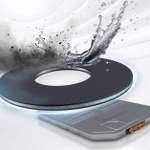 Trelleborg Sealing Solutions has just launched the Rubore® Washer, a unique solution offering virtually leak-free sealing beneath screwheads to safeguard critical systems in vehicles, especially electric ones.
Trelleborg Sealing Solutions has just launched the Rubore® Washer, a unique solution offering virtually leak-free sealing beneath screwheads to safeguard critical systems in vehicles, especially electric ones.
Read the full article.
How Reell electric wrap spring clutches work
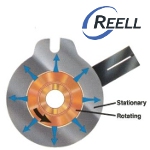 Electric wrap spring clutches are ideally suited for critical timing applications requiring consistent, repeatable engagement and disengagement performance. Wrap spring technology used in Reell clutches provides the capability to transmit a large amount of torque in a small size -- package sizes smaller than other clutch technologies such as friction disk, tooth, or magnetic particle. Reell's technology has very positive engagement characteristics and also limits the effects of wear.
Electric wrap spring clutches are ideally suited for critical timing applications requiring consistent, repeatable engagement and disengagement performance. Wrap spring technology used in Reell clutches provides the capability to transmit a large amount of torque in a small size -- package sizes smaller than other clutch technologies such as friction disk, tooth, or magnetic particle. Reell's technology has very positive engagement characteristics and also limits the effects of wear.
Read this informative Reell article.
New 'breathable' rupture disk tech provides overpressure and vacuum relief
 To increase equipment safety and reliability, a new rupture disk technology activates at a set burst pressure, but it can also "breathe" to relieve minor pressure fluctuations. The patent-pending, dual-function device from BS&B Safety Systems is ideal for use on low-pressure vessels that are susceptible to ambient temperature changes.
To increase equipment safety and reliability, a new rupture disk technology activates at a set burst pressure, but it can also "breathe" to relieve minor pressure fluctuations. The patent-pending, dual-function device from BS&B Safety Systems is ideal for use on low-pressure vessels that are susceptible to ambient temperature changes.
Read the full article.
Engineer's Toolbox: 9 considerations for specifying a slewing ring bearing
 In applications that require a bearing to support a structure while it rotates (e.g., cranes, radar, tank turrets), premature bearing failure can put people and equipment at risk. While slewing ring bearings have proven themselves countless times in such applications, designers must consider many factors when specifying them. According to engineers at Kaydon, the bearing's support structure, mounting (including bolt strength, tensioning, and hole patterns), installation, and even storage are all factors in a bearing's success or failure.
In applications that require a bearing to support a structure while it rotates (e.g., cranes, radar, tank turrets), premature bearing failure can put people and equipment at risk. While slewing ring bearings have proven themselves countless times in such applications, designers must consider many factors when specifying them. According to engineers at Kaydon, the bearing's support structure, mounting (including bolt strength, tensioning, and hole patterns), installation, and even storage are all factors in a bearing's success or failure.
Read the full article.
ClampDisk micro fastener is new alternative for automotive and consumer electronics
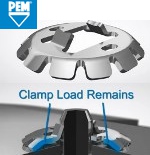 Designed as a unique alternative in assemblies for the automotive and consumer electronics markets, the ClampDisk Press-on Fastener is a new offering from PennEngineering that delivers a fast, simple way to achieve sheet-to-sheet clamped fastening while replacing the use of standard screws, nuts, and adhesives. The most common challenges that can be eliminated or reduced by using ClampDisk include over installation, cross threading, stripped screw heads, broken screws, and damaged product. This fastener can be removed easily with a sharp-edged tool.
Designed as a unique alternative in assemblies for the automotive and consumer electronics markets, the ClampDisk Press-on Fastener is a new offering from PennEngineering that delivers a fast, simple way to achieve sheet-to-sheet clamped fastening while replacing the use of standard screws, nuts, and adhesives. The most common challenges that can be eliminated or reduced by using ClampDisk include over installation, cross threading, stripped screw heads, broken screws, and damaged product. This fastener can be removed easily with a sharp-edged tool.
Learn more and see how ClampDisk works.
New nylon constant torque hinge
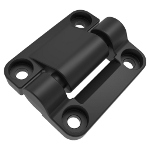 Southco has expanded its line of E6 Constant Torque Hinges with a compact, nylon version designed for small applications. The newest addition to the company's E6 50 Constant Torque Position Control Hinge series measures 45 mm with a torque range of 4 to 16 in./lb and is 65% lighter compared to the standard E6 50 Hinge. It provides constant resistance throughout the entire range of motion, enabling users to easily position doors, display screens, and other mounted components and hold them securely at any desired angle.
Southco has expanded its line of E6 Constant Torque Hinges with a compact, nylon version designed for small applications. The newest addition to the company's E6 50 Constant Torque Position Control Hinge series measures 45 mm with a torque range of 4 to 16 in./lb and is 65% lighter compared to the standard E6 50 Hinge. It provides constant resistance throughout the entire range of motion, enabling users to easily position doors, display screens, and other mounted components and hold them securely at any desired angle.
Learn more.
What injection molding material do I use?
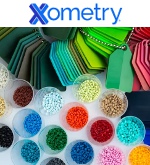 How do you decide what type of plastic to use for your next injection molding project? Xometry can help you narrow your choices. Discover the different strengths and applications for materials that could be ideal for your application by learning about the most common plastic injection molding materials in detail.
How do you decide what type of plastic to use for your next injection molding project? Xometry can help you narrow your choices. Discover the different strengths and applications for materials that could be ideal for your application by learning about the most common plastic injection molding materials in detail.
Read this detailed Xometry article.
What are carbon composite bellows springs?
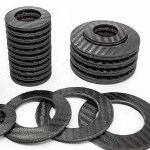 The Carbon Composite Bellows Spring (CCBS) from MW Components is a system of carbon fiber elements that combine to work as a high-performance, lightweight, and design-flexible compression spring meant to replace coil springs or metallic Belleville disc springs. A functional spring is made from several individual elements paired and joined to make a stack. The stack spring rate is determined by the number of elements, the base rate of each element, and their series or parallel orientation in the stack. Applications include motorsports, aerospace, and high-performance activities.
The Carbon Composite Bellows Spring (CCBS) from MW Components is a system of carbon fiber elements that combine to work as a high-performance, lightweight, and design-flexible compression spring meant to replace coil springs or metallic Belleville disc springs. A functional spring is made from several individual elements paired and joined to make a stack. The stack spring rate is determined by the number of elements, the base rate of each element, and their series or parallel orientation in the stack. Applications include motorsports, aerospace, and high-performance activities.
Learn more.
Conductive Brush Ring overcomes current leakage in EV powertrains
 SKF's new Conductive Brush Ring paves the way to greater reliability and longer life in high-performance electric vehicle powertrain systems. Using pure carbon fiber bristles, it provides a reliable electrical connection between an EV eAxle rotor shaft and its housing. When used in combination with SKF Hybrid ceramic ball bearings, it helps to alleviate parasitic current effects that can lead to premature failure in bearings and other components. Available in different configurations for wet (oil-lubricated) motor designs -- and soon for dry (sealed) applications.
SKF's new Conductive Brush Ring paves the way to greater reliability and longer life in high-performance electric vehicle powertrain systems. Using pure carbon fiber bristles, it provides a reliable electrical connection between an EV eAxle rotor shaft and its housing. When used in combination with SKF Hybrid ceramic ball bearings, it helps to alleviate parasitic current effects that can lead to premature failure in bearings and other components. Available in different configurations for wet (oil-lubricated) motor designs -- and soon for dry (sealed) applications.
Learn more.
hyperMILL 2024 CAD/CAM software suite
 OPEN MIND Technologies has introduced its latest hyperMILL 2024 CAD/CAM software suite, which includes a range of powerful enhancements to its core toolpath capabilities, as well as new functionality for increased NC programming efficiency in applications ranging from 2.5D machining to 5-axis milling. New and enhanced capabilities include: Optimized Deep Hole Drilling, a new algorithm for 3- and 5-axis Rest Machining, an enhanced path layout for the 3D Plane Machining cycle, better error detection, and much more.
OPEN MIND Technologies has introduced its latest hyperMILL 2024 CAD/CAM software suite, which includes a range of powerful enhancements to its core toolpath capabilities, as well as new functionality for increased NC programming efficiency in applications ranging from 2.5D machining to 5-axis milling. New and enhanced capabilities include: Optimized Deep Hole Drilling, a new algorithm for 3- and 5-axis Rest Machining, an enhanced path layout for the 3D Plane Machining cycle, better error detection, and much more.
Learn more.
One-part epoxy changes from red to clear under UV
 Master Bond UV15RCL is a low-viscosity, cationic-type UV-curing system with a special color-changing feature. The red material changes to clear once exposed to UV light, indicating that there is UV light access across the adhesive material. Although this change in color from red to clear does not indicate a full cure, it does confirm that the UV light has reached the polymer. This epoxy is an excellent electrical insulator. UV15RCL adheres well to metals, glass, ceramics, and many plastics, including acrylics and polycarbonates.
Master Bond UV15RCL is a low-viscosity, cationic-type UV-curing system with a special color-changing feature. The red material changes to clear once exposed to UV light, indicating that there is UV light access across the adhesive material. Although this change in color from red to clear does not indicate a full cure, it does confirm that the UV light has reached the polymer. This epoxy is an excellent electrical insulator. UV15RCL adheres well to metals, glass, ceramics, and many plastics, including acrylics and polycarbonates.
Learn more.
SPIROL Press-N-Lok™ Pin for plastic housings
 The Press-N-Lok™ Pin was designed to permanently retain two plastic components to each other. As the pin is inserted, the plastic backfills into the area around the two opposing barbs, resulting in maximum retention. Assembly time is quicker, and it requires lower assembly equipment costs compared to screws and adhesives -- just Press-N-Lok™!
The Press-N-Lok™ Pin was designed to permanently retain two plastic components to each other. As the pin is inserted, the plastic backfills into the area around the two opposing barbs, resulting in maximum retention. Assembly time is quicker, and it requires lower assembly equipment costs compared to screws and adhesives -- just Press-N-Lok™!
Learn more about the new Press-N-Lok™ Pin.
Why hybrid bearings are becoming the new industry standard
 A combination of steel outer and inner rings with ceramic balls or rollers is giving hybrid bearings unique properties, making them suitable for use in a wide range of modern applications. SKF hybrid bearings make use of silicon nitride (twice as hard as bearing steel) rolling elements and are available as ball bearings, cylindrical roller bearings, and in custom designs. From electric erosion prevention to friction reduction and extended maintenance intervals, learn all about next-gen hybrid bearings.
A combination of steel outer and inner rings with ceramic balls or rollers is giving hybrid bearings unique properties, making them suitable for use in a wide range of modern applications. SKF hybrid bearings make use of silicon nitride (twice as hard as bearing steel) rolling elements and are available as ball bearings, cylindrical roller bearings, and in custom designs. From electric erosion prevention to friction reduction and extended maintenance intervals, learn all about next-gen hybrid bearings.
Read the SKF technical article.
3M and Ansys train engineers on simulating adhesives
 Ansys and 3M have created an advanced simulation training program enabling engineers to enhance the design and sustainability of their products when using tapes and adhesives as part of the design. Simulation enables engineers to validate engineering decisions when analyzing advanced polymeric materials -- especially when bonding components made of different materials. Understand the behavior of adhesives under real-world conditions for accurate modeling and design.
Ansys and 3M have created an advanced simulation training program enabling engineers to enhance the design and sustainability of their products when using tapes and adhesives as part of the design. Simulation enables engineers to validate engineering decisions when analyzing advanced polymeric materials -- especially when bonding components made of different materials. Understand the behavior of adhesives under real-world conditions for accurate modeling and design.
Read this informative Ansys blog.
Eco-friendly lubricant additives demonstrate 50% less friction and 10x decrease in equipment wear

Testing with ORNL tribology equipment found that new ionic liquid-based lubricant additives developed for water turbines significantly reduced friction and equipment wear. [Credit: Genevieve Martin, ORNL/U.S. Dept. of Energy]
Scientists at the Department of Energy's Oak Ridge National Laboratory (ORNL) have developed lubricant additives that protect both water turbine equipment and the surrounding environment.
Each year, roughly 2.47 billion gallons of lubricating oil are used in the United States alone for engines and industrial machinery, according to DOE, with about half eventually finding its way into the environment.
While environmentally acceptable lubricants are available, they are not optimized with additives that can greatly improve performance while posing minimal environmental impact if accidentally released. To create nontoxic, biodegradable, and high-performing lubricant additives for water power turbines, researchers turned to ionic liquids, or ILs: organic liquid salts that mix well with oil, reduce friction between bearings and gears, and are stable in a range of temperatures.
A team of materials and environmental scientists at ORNL worked together to design, synthesize, and test top-candidate ILs of ammonium phosphate and phosphonium phosphate that provide a good mix of properties.
When added to base oils, the ILs demonstrated 50% less friction and a tenfold decrease in equipment wear compared to a commercially available gear oil, while meeting federal standards for environmental toxicity and biodegradability, as described in ACS Sustainable Chemistry & Engineering.
The project builds on more than 20 years of IL research at ORNL, including the development of lubricant additives designed to reduce engine wear and boost fuel economy in vehicles.
"Our previous work showed us that you could dramatically increase the performance of lubricants with the addition of just 1% or even a half percent of ILs," said ORNL's Jun Qu, who leads the project and the Surface Engineering and Tribology group at ORNL.
This time around, scientists sought to create a nontoxic additive for use in turbines installed in aquatic environments, generating electricity using waves, tides, and ocean and river currents. Although ILs are generally considered less toxic than conventional lubricant ingredients, their impact on the environment has not been closely studied.
"On the environmental side, there are three main factors we care about with these lubricants," said Teresa Mathews, lead for the Biodiversity and Ecosystem Health group at ORNL. "They have to be highly performing, we don't want them to be toxic to any aquatic organisms, and if there's a spill, we don't want the lubricants to be compounds that last in the environment. We want them to degrade very rapidly."
Pursuing a cleaner formula
The team first sought to eliminate potential toxic elements such as fluorine and chlorine and metals such as zinc and iron from the candidate ILs. They also focused on creating ILs made up of shorter hydrocarbon chains -- chains containing fewer than six carbon atoms -- that are generally considered to be less toxic.
"We found a four-carbon chain to be the sweet spot," Qu said. Going shorter than four carbons resulted in an IL that didn't mix well with oil and was less thermally stable, he added.
Friction testing was accomplished with metal pieces simulating turbine gears and bearings coated with a lubricant containing the IL. Resulting surface wear of the pieces was characterized using electron microscopy at the Center for Nanophase Materials Sciences, a DOE Office of Science user facility at ORNL.
These particular ILs are fairly straightforward to produce and can be easily scaled up for commercialization, said Huimin Luo, a chemist in ORNL's Manufacturing Science Division who led the chemical synthesis work.
To determine the additives' environmental impact, ORNL ecotoxicologist Louise Stevenson conducted toxicity and biodegradability tests in ORNL's Environmental Toxicology Laboratory, where assessments are routinely conducted for DOE, the Department of Defense, and other agencies. Following Environmental Protection Agency protocols, the toxicity tests used Ceriodaphnia, tiny planktonic crustaceans commonly known as water fleas that sit at the bottom of the food chain, have a short life cycle and rapid reproduction rate, and are highly sensitive to environmental conditions.
Tiny plankton provide big insights
The organisms "are like canaries in a coal mine for aquatic toxicity, because they are filter feeders and interact with a lot of water," Stevenson said. "In a seven-day test, we'll get three to four rounds of reproduction with daily hatching, so we can look for both lethal effects and sublethal effects such as reproductive and growth impacts that have an effect on population survival."
While the environmentally acceptable lubricant base oils had no effect on the crustaceans, the commercial lubricant additives and two early IL compounds were found to be extremely toxic to the organisms, resulting in 100% mortality within one to three days after exposure. The team's ultimate designs for short-chain ammonium phosphate and phosphonium phosphate IL additives resulted in 90 to 100% survival rates after seven days.
The final, top-performing IL-enhanced lubricants were also found to be highly biodegradable compared to standard lubricant additives. Testing involved exposing the compounds to aquatic microbes and then measuring the rate of carbon dioxide production as the microbes broke down the materials.
High-performing, environmentally friendly lubricants designed specifically for marine energy turbines are important for other reasons, including equipment durability. Lubricant technology currently in use for marine turbines was borrowed from wind turbines, which are serviced every six to 18 months, Qu said. However, tidal turbines installed in the ocean or rivers are typically designed for service every six years and operate under much harsher conditions.
The project is expected to focus next on further development of IL lubricant additives specifically for use in tidal turbines operating in the ocean and exposed to potential seawater contamination and pressure and temperature extremes.
Source: Oak Ridge National Laboratory
Published May 2024
Rate this article
View our terms of use and privacy policy

